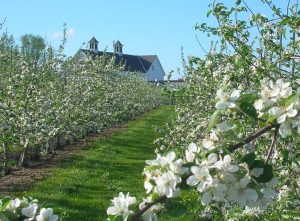Growing Fruit Trees in Maine
 By Renae Moran, UMaine Extension Tree Fruit Specialist, and Glen Koehler, UMaine Associate Scientist/Integrated Pest Management
By Renae Moran, UMaine Extension Tree Fruit Specialist, and Glen Koehler, UMaine Associate Scientist/Integrated Pest Management
Fruit trees are grown for their attractive blossoms in spring, for their healthful fruit in the fall, or to have fruit bearing trees as part of a garden landscape. Another reason for maintaining a home orchard is to continue the cultivation of hard-to-find varieties that are no longer commercially available, such as Belle de Boskoop apples or Green Gage plums. Whatever the reason, a knowledge of the cultural requirements can prevent problems from occurring and add a new dimension to home gardening.
The purpose of this website is to provide the home orchardist with the knowledge to successfully grow fruit trees under the conditions that exist in Maine. Cultural practices for apple, pear, peach, cherry, plum, and apricot are described here. For additional information about growing plums, see Plum Production in Maine, Bulletin #2034, University of Maine Cooperative Extension. For information on growing peaches, see Growing Peaches in Maine, Bulletin #2068, University of Maine Cooperative Extension.
Orchards can be low maintenance or high maintenance depending on the desires of the gardener. When the goal is to produce a large supply of blemish-free fruit, an orchard will require annual care. Trees planted for aesthetics or as a source of food for wildlife require little or no care.
If you would like to know more about tree fruit production or other types of gardening, please contact the University of Maine Cooperative Extension or the Highmoor Farm or visit the UMaine Extension website.
The University of Maine Agriculture and Forest Experiment Station at the Highmoor Farm
P.O. Box 179
Monmouth, ME 04259
207.933.2100 ext. 105
E-mail: rmoran@maine.edu
University of Maine Cooperative Extension Administrative Offices
5741 Libby Hall
Orono, ME 04469-5741
207.581.3188
1.800.287.0274 (in Maine)
E-mail: extension@maine.edu
Website: extension.umaine.edu
Additional contributors: James Schupp, Majorie Peronto, and David Handley. The information presented here was generated from years of research at the agricultural experiment stations throughout the United States and other countries.
